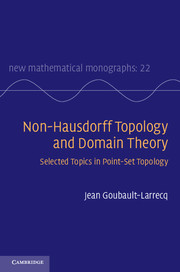Book contents
6 - Metrics, quasi-metrics, hemi-metrics
Published online by Cambridge University Press: 05 May 2013
Summary
Metrics, hemi-metrics, and open balls
A natural instance of topological space is given by metric spaces, as already studied in Chapter 3.
Note that metrics are symmetric: the distance between x and y is the same as the distance between y and x. There is no need to assume so in all generality, and Lawvere (2002) has already rejected the symmetry axiom as being artificial in various situations – although, as we shall see, symmetry certainly makes our lives easier in several important cases, notably in the study of completeness (see Section 7.1). We are led to the following definition.
Definition 6.1.1 (Hemi-metric, quasi-metric) Let X be a set. A hemi-metric d on X is a map from X × X to such that:
d(x, x) = 0 for every x ∈ X;
(Triangular inequality) d(x, y) ≤ d(x, z) + d(z, y) for all x, y, z ∈ X.
A set X with a hemi-metric is called a hemi-metric space.
A hemi-metric d, or a hemi-metric space, is said to be T0 if and only if d(x, y) = d(y, x) = 0 implies x = y. It is T1 if and only if the sole equality d(x, y) = 0 already implies x = y.
A quasi-metric is a T0 hemi-metric. A T0 hemi-metric space is called a quasi-metric space.
- Type
- Chapter
- Information
- Non-Hausdorff Topology and Domain TheorySelected Topics in Point-Set Topology, pp. 203 - 259Publisher: Cambridge University PressPrint publication year: 2013
- 1
- Cited by

